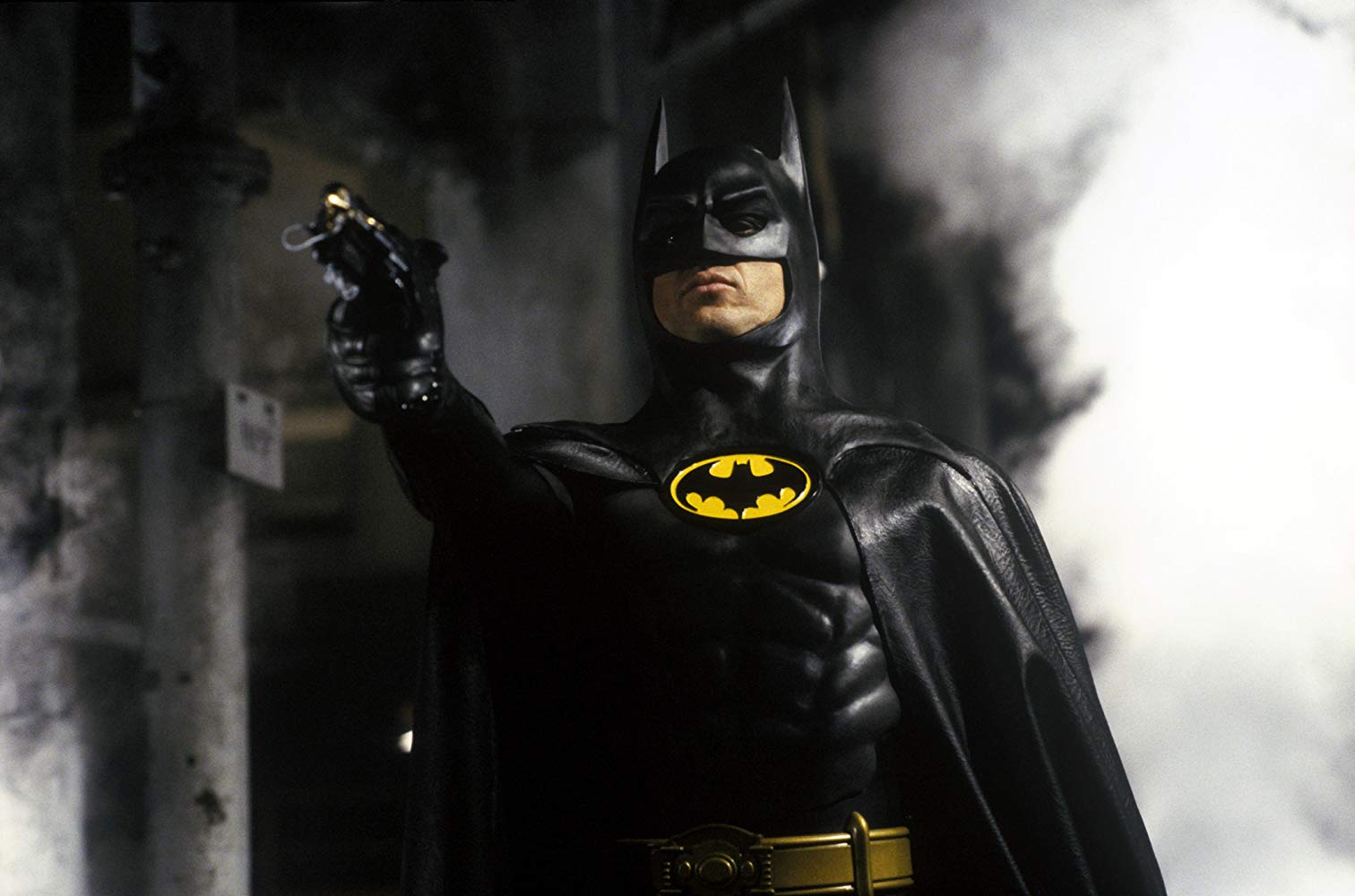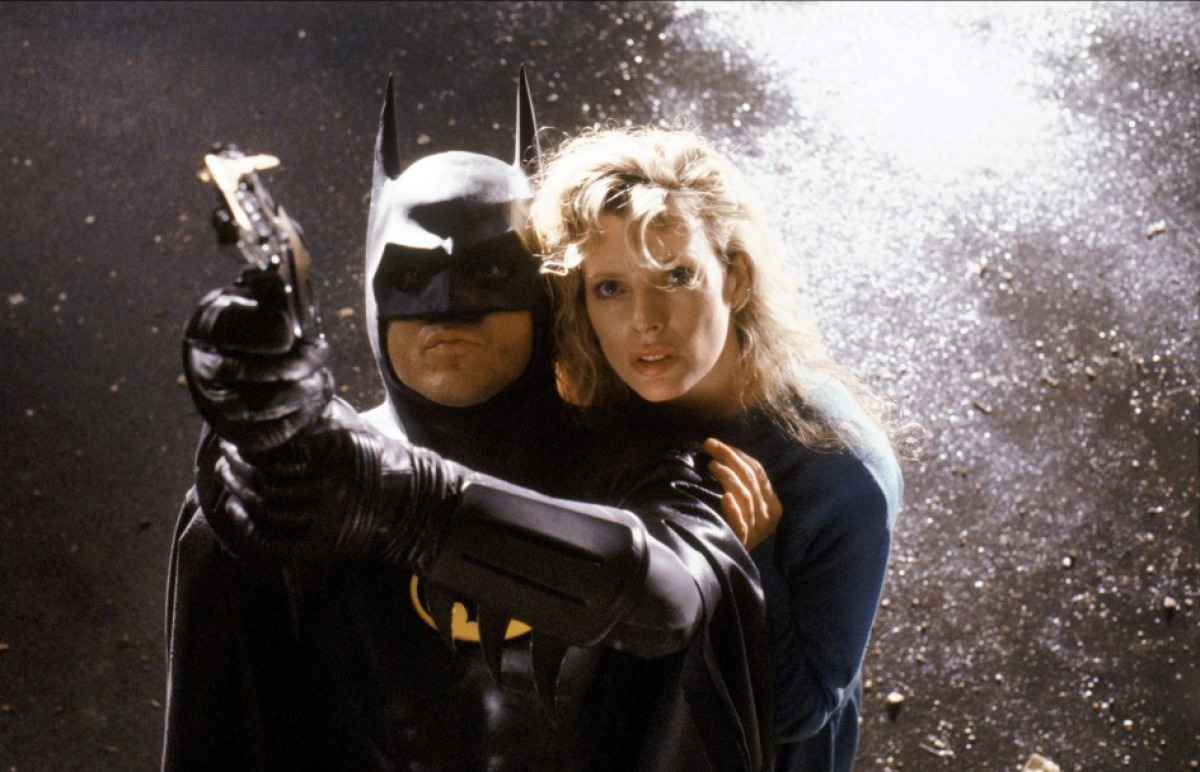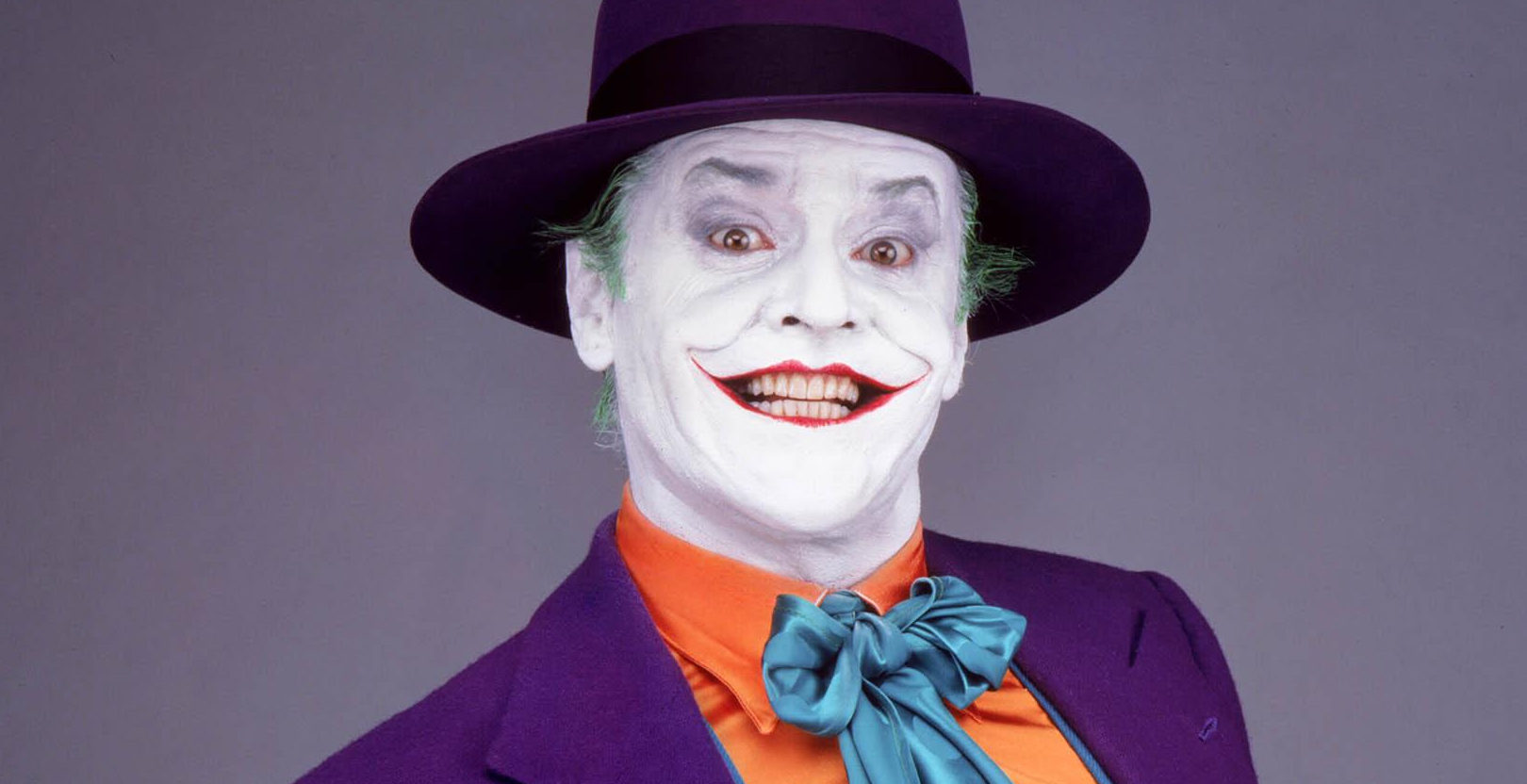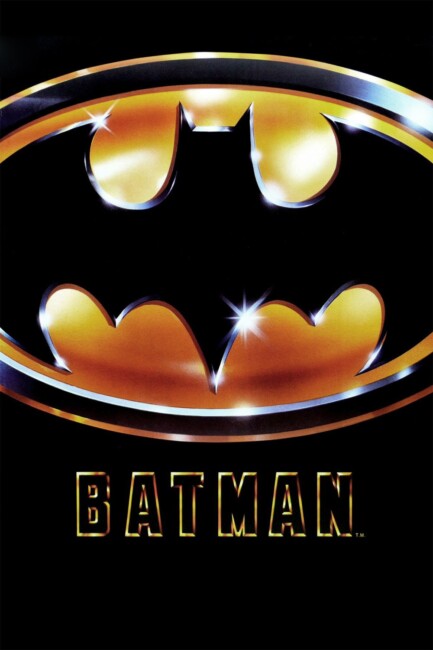USA. 1989.
Crew
Director – Tim Burton, Screenplay – Sam Hamm & Warren Skaaren, Story – Sam Hamm, Based on the Comic Book Created by Bob Kane, Producers – Peter Guber & Jon Peters, Photography – Roger Pratt, Music – Danny Elfman, Songs – Prince, Visual Effects Supervisor – Derek Meddings, Special Effects Supervisor – John Evans, Makeup – Suzanne Reynolds, Joker Makeup – Nick Dudman, Production Design – Anton Furst. Production Company – The Guber-Peters Co/Polygram.
Cast
Michael Keaton (The Batman/Bruce Wayne), Jack Nicholson (The Joker/Jack Napier), Kim Basinger (Vicki Vale), Robert Wuhl (Alexander Knox), Michael Gough (Alfred Pennyworth), Tracey Walter (Bob), Jack Palance (Carl Grissom), Pat Hingle (Commissioner James Gordon), William Hootkins (Eckhardt), Jerry Hall (Alicia)
Plot
The criminals of Gotham City are being terrorised by a mysterious masked and caped bat-man of seemingly supernatural powers, who appears out of and equally mysteriously disappears back into the shadows. Behind the mask of Batman is millionaire Bruce Wayne. Aided by an array of gadgets, Bruce has dedicated his life to fighting crime after witnessing the murder of his parents by a petty hood as a child. During one crime swoop, he throws gangland arm-man Jack Napier into a vat of toxic waste. Napier emerges with his skin bleached white, his hair green and face frozen in a permanent rictus grin. His mind snapped, Napier names himself The Joker and starts his own wave of terror, delighting in crimes of insanity.
For some years now, Batman has won numerous comic-book readers’ polls as the most popular of all comic-book superheroes. Created by Bob Kane (and for any years an uncredited Bill Finger), the character first appeared in Detective Comics #27 in May, 1939. Kane originally based Batman on Zorro and intended the figure as a dark avenger who chose the likeness of the bat to strike terror into the hearts of villains. Batman has become the archetypal dark and angry comic-book avenger.
Up until this big-budget film, Batman has not fared particularly well on film. There were two serials produced in the 1940s, Batman (1943) and Batman and Robin (1949), which featured Batman and Robin running about in costumes that displayed visible wrinkles and whose po-faced serial superheroics lacked any of the mood of the comic-book. Even worse was the tv series Batman (1966-8) and its one film offshoot Batman (1966) where the costumed heroics and noble crime-fighting epithets were played up for the maximum degree of intentional silliness.
There is no clear reason why Batman should have fared so poorly on film – after all his DC stablemate Superman in his two serial incarnations, Superman (1948) and Atom Man vs. Superman (1950), and the 1950s tv series Adventures of Superman (1952-8) and the first two Christopher Reeve films – Superman (1978) and Superman II (1980) – fared considerably better as a cinematic character, despite the fact that the superpowered Superman is seemingly a far more cinematically difficult character to pull off than Batman, requiring much more in the way of special effects. The answer lies all in the mood. Superman is essentially an All-American hero – a Boy Scout in a cape, his heroics are the heroics that American cinema has traded in since time immemorial, while on the other hand the dark moodiness that essentially is Batman is something that it took the cinematic pulp medium that filmed comic-books were essentially banished to a long time to discover.

The Batman film project had been announced as long ago as 1979 by producers Michael E. Uslan and Benjamin Melniker who hoped to cash in on the success of the Christopher Reeve Superman in 1978. Melniker and Uslan found difficulty in getting the project off the ground and in the interim went away and filmed another DC superhero with Swamp Thing (1982). The Batman film sat around as an on-again, off-again project over the next decade where it passed through a number of directorial hands, including Joe Dante, Ivan Reitman and Robert Zemeckis. When the project finally was given the green light, it attracted some controversy, variously being protested against by comic-book fans for the casting of Michael Keaton, previously a comedy actor, as Batman/Bruce Wayne, and by Adam West of tv’s Batman who felt the producers had some obligation to put him in the show. Finally, Batman emerged with the then relatively unknown Tim Burton, who was riding riding high on the success of Beetlejuice (1988), at the helm.
The result was a runaway sensation. This was prior to Jurassic Park (1993) and Star Wars Episode I: The Phantom Menace (1999) where Batman could probably have won some award for the film with the biggest hype campaign ever – it was the first of the films that came as more of a cultural phenomenon than a film. The phenomenon was something that one needed to dissociate themselves from before criticism could begin. In New Zealand, where one had to wait six months following its Stateside release to see the film, the effect was particularly noticeable. The six months was spent in sales-hype (entire shops were devoted to the sales of Bat-paraphernalia) and one had to dissociate a backlash against the hype from the hype as well before one sat down to see the film.
Seen, Batman is a glitteringly beautiful incarnation of a comic-book. It is a four-colour comic-book articulated to a degree one would never have imagined possible. Writers Sam Hamm and Warren Skaaren have studied The Dark Knight Returns (1986) and The Killing Joke (1988) – the graphic novels that redefined Batman at DC and gave birth to the dark, nihilistic comic-books superheroes of the mid-1980s – and distilled them to show a Bruce Wayne trembling with barely suppressed psychosis, only finding his clarity and identity behind his grim, vigilante mask. (The script even copies The Joker’s fall into the chemical vat direct from The Killing Joke).

Batman is a film that searches deep inside the funny faces, looks into dark, violent psychological recesses and finally paints the characters running about in children’s party costumes not as absurd caricatures like the 1966 tv series, but as driven necessities. Batman was possibly the darkest Hollywood blockbuster ever made up to that point. This is the dark side of the Superman alter ego, more Jekyll and Hyde than a faux-pasing comedy of manners like Clark Kent was.
Just as good as Batman, the film’s The Joker is a magnificently insane creation. In fact, Michael Keaton’s Batman is upstaged by Jack Nicholson as The Joker who gets fully three-quarters of the film and takes the opportunity to play up in his broadest, most over-the-top performance since The Shining (1980). Jack Nicholson is good enough that even inside such a broad and over-the-top performance, he can peel it away to show the insanity behind the mask. The way the story plumbs his madness, even adds a disturbing psycho-sexual element, goes far beyond what the comics ever tried.
Tim Burton specialises in worlds where production design, photography, costuming and mood combine into a seamless vision. One of the most vivid elements of the film are the sets. Production designer Anton Furst creates a grimy retro-1940s futurist netherworld of dripping boiler-plates, bolted metal walls, twisted gargoyle overhangs and bizarre art displays that combine samurai armour with gas masks. Gotham City is seemingly a world where urban planning has been thrown to the wind and factories and skyscrapers blend together in the downtown. The Bat-mobile is a sleek, black armoured death machine that takes the breath away. The Batman costume, all in glistening black rubber and kept in stylised poses just like the comic-book panel, is far from any of the baggy tights and floppy capes that filled the serials or 1960s tv series. The only minus point about the film is the miscalculated Prince soundtrack – it is well below the standards of the usually worthwhile Prince and inappropriate to the film’s tone.
Batman is a dazzling and sophisticated film. Relentlessly enthralling, funny, dark and with Tim Burton scaling operatic heights with the dark psychology of the characters. The dark, driven look became one that was copied by numerous comic-book adaptations throughout the 1990s that sought to follow Batman‘s success, including the likes of tv’s The Flash (1990-1) and M.A.N.T.I.S. (1995) and films such as Darkman (1990), The Crow (1994) and sequels, The Shadow (1994), Spawn (1997) and Daredevil (2003).

There were also a number of sequels and offshoots. Tim Burton and Michael Keaton returned for Batman Returns (1992), a film that is equally as brilliant as this. Unfortunately the reins of the series were then turned over to the incompetent Joel Schumacher who made Batman Forever (1995) and Batman & Robin (1997), the latter being the single worst film of the 1990s. There were numerous plans announced for a fifth Batman film, which floundered in development for the better part of a decade before finally emerging as Batman Begins (2005) starring Christian Bale as Batman, which brought respect back to the series. A 71-year old Michael Keaton later returned as Batman in The Flash (2023). (See below for the other Batman films and tv series).
Tim Burton would go on to enormously successful career. He had previously made the kitsch Pee-Wee’s Big Adventure (1985) and the bizarre ghost story Beetlejuice (1988) and would go onto direct the likes of the genteel artificial boy fairy-tale Edward Scissorhands (1990); Ed Wood (1994) about the world’s worst director; the alien invasion spoof Mars Attacks! (1996); the ghost story Sleepy Hollow (1999); the remake of Planet of the Apes (2001); Big Fish (2003) about an habitual teller of tall tales; Charlie and the Chocolate Factory (2005); the stop-motion animated Gothic Corpse Bride (2005); the musical Sweeney Todd: The Demon Barber of Fleet Street (2007); Alice in Wonderland (2010); the film remake of the tv series Dark Shadows (2012), the stop-motion animated Frankenweenie (2012); the non-genre biopic Big Eyes (2014); Miss Peregrine’s Home for Peculiar Children (2016); the live-action remake of Dumbo (2019); and Beetlejuice Beetlejuice (2024). Burton also produced Henry Selick’s darkly brilliant puppet fantasies The Nightmare Before Christmas (1993) and James and the Giant Peach (1996); as well as the live-action conte cruel Cabin Boy (1994), the animated 9 (2009), Abraham Lincoln, Vampire Hunter (2012) and Alice Through the Looking Glass (2016). The Death of “Superman Lives”: What Happened? (2015) is a fascinating documentary about Burton’s failed Superman Lives project.
Other Batman appearances on screen are:-
- Batman (1943) and Batman and Robin (1949), two fifteen-chapter serials from Columbia where Batman was played by Lewis Wilson and Robert Lowery and Robin by Douglas Croft and John Duncan
- the campy tv series Batman (1966-8) starring Adam West and Burt Ward as Batman and Robin, which produced one film spin-off with Batman (1966)
- the animated tv series The New Adventures of Batman (1977-8)
- the animated series Batman (1992-4) inspired by the Tim Burton films and its follow-up The New Batman Adventures (1997-9), which spawned several film spin-offs with Batman: Mask of the Phantasm (1993), Batman and Mr Freeze: SubZero (1998), The Batman Superman Movie: World’s Finest (1998) and Batman: Mystery of the Batwoman (2003). There was also Batman Beyond/Batman of the Future (1999-2001), the futuristic follow-up series from the same creative team featuring an aging Bruce Wayne and his young apprentice, which also spun off one animated film Batman Beyond: Return of the Joker (2000) and another animated tv series Static Shock (2000-4), which featured several appearances from Batman. Batman also appears in the same team’s Justice League/Justice League Unlimited (2001-5)
- Christopher Nolan’s revival of the franchise with Batman Begins (2005), The Dark Knight (2008) and The Dark Knight Rises (2012) starring Christian Bale
- the DC Universe Original Animated Movies Superman/Batman: Public Enemies (2009), Batman: Under the Red Hood (2010), Superman & Batman: Apocalypse (2010), Batman: Year One (2011), Batman: The Dark Knight Returns Part I (2012), Batman: The Dark Knight Returns Part II (2013), Batman: Assault on Arkham (2014), Son of Batman (2014), Batman vs. Robin (2015), Batman: Bad Blood (2016), Batman: The Killing Joke (2016), Batman and Harley Quinn (2017), Batman: Gotham By Gaslight (2018), Batman: Hush (2019), Batman: Soul of the Dragon (2021), Batman: The Long Halloween Part One (2021), Batman: The Long Halloween Part Two (2021), Batman and Superman: Battle of the Super Sons (2022) and Batman: The Doom That Came to Gotham (2023), as well as Batman: Gotham Knight (2008), a compilation of anime Batman shorts. Batman also appears in the DC Original Animated Movies Justice League: The New Frontier (2008), Justice League: Crisis on Two Earths (2010), Justice League: Doom (2012), Justice League: The Flashpoint Paradox (2013), Justice League: War (2014), Justice League: Throne of Atlantis (2015), Justice League: Gods and Monsters (2015), Justice League vs Teen Titans (2016), Justice League Dark (2017), The Death of Superman (2018), Justice League vs The Fatal Five (2019), Justice League Dark: Apokolips War (2020), Superman: Red Son (2020), Injustice (2021), Justice Society: World War II (2021), Justice League: Warworld (2023), Legion of Super-Heroes (2023), Justice League: Crisis on Infinite Earths Part One (2024), Justice League: Crisis on Infinite Earths Part Two (2024) and Justice League: Crisis on Infinite Earths Part Three (2024)
- the animated series The Batman (2004-8), which badly revised the basics of the series and was also spun off into a film with The Batman vs. Dracula (2005)
- two further animated series Batman: The Brave and the Bold (2008-11), which placed Batman alongside other DC superheroes and had one crossover film spinoff with Scooby-Doo! & Batman: The Brave and the Bold (2018), and Beware the Batman (2013-4)
- the live-action tv series Gotham (2014-9), which tells the origin stories of the familiar characters and villains as Bruce Wayne (David Mazouz) grows up
- Batman turns up as an animated character in The Lego Movie (2014) and The Lego Movie 2 (2019) voiced by Will Arnett and gets a whole film to himself in The Lego Batman Movie (2017)
- the animated films Batman Unlimited: Animal Instincts (2015), Batman Unlimited: Monster Mayhem (2015) and Batman Unlimited: Mechs vs Mutants (2016) spun off from a line of action figures
- Batman V Superman: Dawn of Justice (2016) with Ben Affleck who went on to appear as Batman in Suicide Squad (2016), featuring a team-up of DC villains including The Joker and Harley Quinn, Justice League (2017) and the extended cut of the latter with Zack Snyder’s Justice League (2021), and The Flash (2023)
- the animated Batman: Return of the Caped Crusaders (2016) and Batman vs. Two-Face (2017) featuring a return of Adam West and Burt Ward
- the anime film Batman Ninja (2018) and its sequel Batman Ninja vs Yakuza League (2025)
- the animated crossover Batman vs Teenage Mutant Ninja Turtles (2019)
- the animated Batman Christmas film Merry Little Batman (2023)
- The Batman (2022) starring Robert Pattinson and the spinoff tv mini-series The Penguin (2024)
- Batman also makes appearances in the line-up of superheroes in various other DC-related animated series such as SuperFriends (1973-7) and The All New SuperFriends Hour (1977-9) and the film DC League of Super Pets (2022)
- Other spin-offs include:- the short-lived live-action tv series Birds of Prey (2002-3), featuring the women of Batman – a paraplegic Batgirl, Cat Woman’s daughter and Harley Quinn and the film Birds of Prey and the Fantabulous Emancipation of One Harley Quinn (2020), starring Margot Robbie’s Harley Quinn
- Catwoman receiving her own films with the Halle Berry starring Catwoman (2004) and the animated Catwoman: Hunted (2022) where she was voiced by Elizabeth Gillies
- The Joker origin story with Joker (2019) starring Joaquin Phoenix and its sequel Joker: Folie a Deux (2024)
- Robin appears as a member of Young Justice (2010-3), the animated tv series Teen Titans (2003-6), which had one film spinoff with Teen Titans: Trouble in Tokyo (2006); the animated tv series Teen Titans Go! (2013– ), which had three film spinoffs with Teen Titans Go! To the Movies (2018), Teen Titans Go! Vs. Teen Titans (2019), Teen Titans Go! See Space Jam (2021) and Teen Titans Go! & DC Super Hero Girls: Mayhem in the Multiverse (2022); and as Nightwing (Brenton Thwaites) in the live-action tv series Titans (2018-23)
- Pennyworth (2019-23), a tv series concerning Alfred (Jack Bannon)’s early years
- Batwoman (2019-22), a tv series starring Ruby Rose, replaced by Wallis Day in the second season, as Bruce Wayne’s cousin Katherine Kane; and from the same production team Gotham Knights (2023- ) featuring the children of assorted Batman mythos characters
- The Batman-Robin relationship is also excrutiatingly spoofed in the Superhero Speed Dating segment of Movie 43 (2013)
- Also of interest is Batman & Bill (2017), a documentary about the unacknowledged co-creator of Batman, Bill Finger.
Trailer here


